The Eukaryotic cell cycle 2: LECTURE 3
1/48
Earn XP
Description and Tags
Irreversibiility, proteolysis and checkpoints
Name | Mastery | Learn | Test | Matching | Spaced |
|---|
No study sessions yet.
49 Terms
p34cdc2/cdc28 also known as
Cdk1
What does it mean that cdc28/cdc2 are required for START and M phase in fission yeast?
Maybe cdc28 can act in a stage specific manner??
How to test this and work this out?
Genetic screens in budding yeast
identified a number of new genes
encoding proteins related to cyclins
Mutant phenotypes and temporal expression of these genes was looked at
observation: They were required to activate Cdc28
In a stage specific manner
for G1/S and for G2/M transitions
What was overall found out
G1, S and M-phase cyclins: stage specific cyclins
In budding yeast
CDK:
Cdc28 → constant
Cyclins→ oscillating for activation
stage specific cyclins

Fission yeast
CDK:
Cdc2 → constant
Cyclins→ oscillating for activation
stage specific cyclins
Analogous START control found in animal cells
Restriction Point
What is the Restriction point
regulatory mechanism in late G1
shifts cells between proliferative and quiescent states
depending on:
nutrients and growth factors
Can they come out of quiescence?
may resume proliferation if have
nutrients and growth factors
restored
Cancer cell restriction point?
Have lost their restriction point control
What the link between START and restriction point suggests?
molecular mechanisms must be conserved too
How we found out more about cell cycle in human cells
genetic and biochemical approaches
screens for functional complementation of yeast cell cycle mutants
with human cDNA
(as done for cloning human cdc2 previously)
Overall: want to find similar functions found in yeast of the proteins we understand to the one found in humans:
so we can know what genes are invovled!
Results from this research
Cdk2, 4 and 6 found
what this means: must be stage-specific Cdk too!
Human cyclins D and E
What this means: G1 controls in yeast and humans are conserved!
Overall info we know about human cell cycle
stage specific cyclin
and
stage specific cdk subunits!
Together: make stage specific CDK complexes
play critical role in ordering evening cell cycle
controlled by oscillating cyclins
how work??
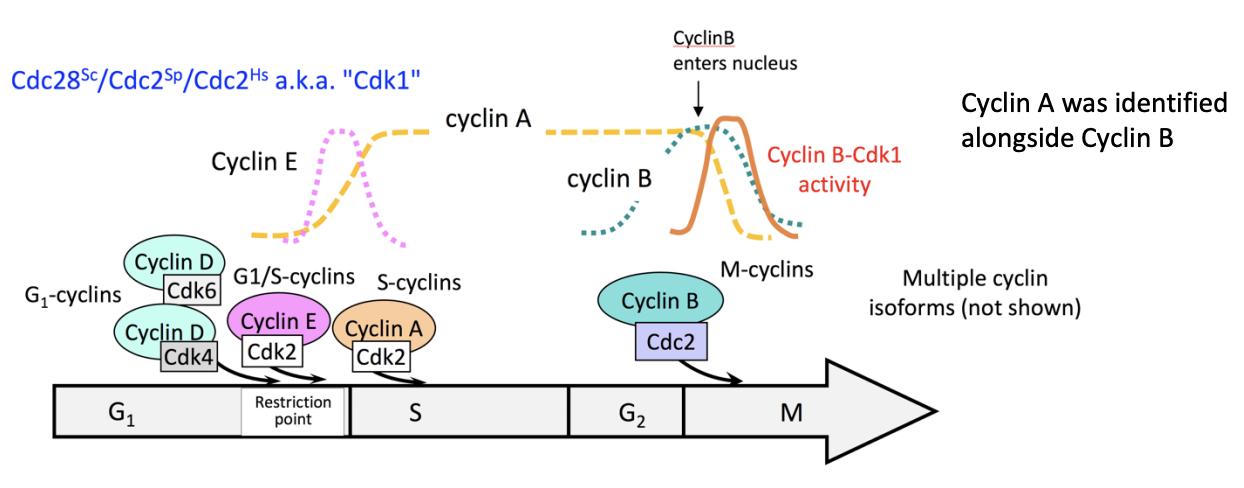
Stage specific accumulation of cyclins is controlled
Transcriptionally
and
Post-transcriptionally
How are these cell cycle transitions made irreversible?
Ubiquitin-dependent proteolysis
targeted destruction of cell cycle regulators
ensures that the regulators (cyclin) oscillators to get from one phase to the next?
contributes to sharp and irreversible cell cycle transitions
How works?
Steps
Ubiquitin activation
conjugation
ligation
What is involved?
E1, E2 and E3 ensymes
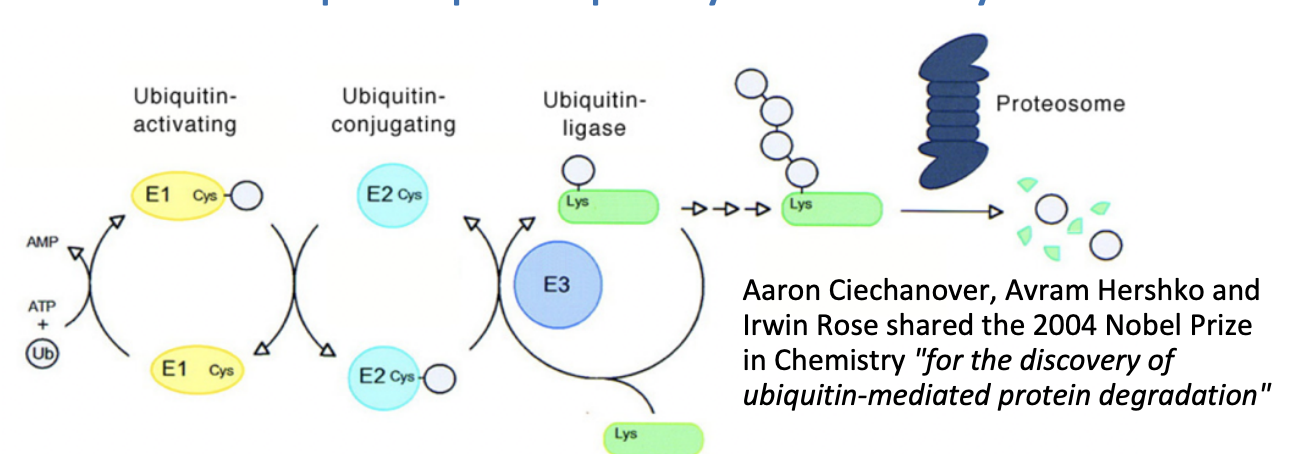
What happens?
E1 and E2 prepare a ubiquitin moiety for..
ligation by the E3 to a lysine side-chain in the target protein
adds a ubiquitin to the protein
Repeated
forms a polyubiquitin chain on the target
Poly-ubiquitinated target then recognised by proteasome
‘cellular chamber of doom’
protein subject to proteolysis
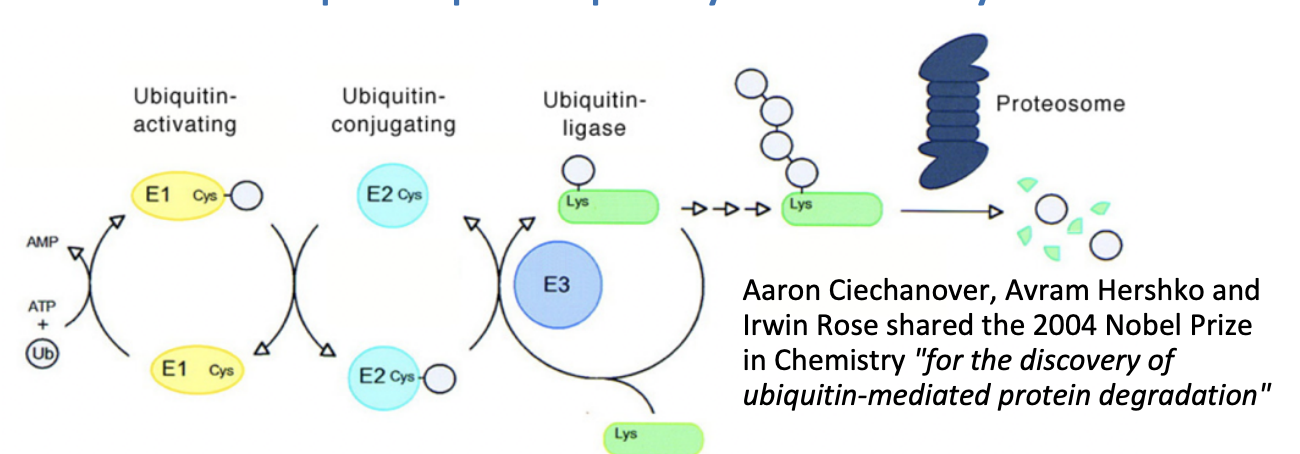
The specical role of E3?
Governs substrate specificity
2 Examples of E3
SCF
APC/C
Play critical roles in targeting cell cycle regulators
SCF
Multisubunit
with core components
Skp1 and Cdc53
and variable F-box protein
for substrate recognition
APC/C
anaphase promoting complex/cyclosome
associated to mutually exclusive activators
Cdc20 or Cdh1
E3s’ mechanism for substrate recognition?
These two examples differ in how they do it but…
Both based on distinctive sequence signatures found in the target:
degrons
Role of SCFs in yeast
Destruction of bound CDK inhibitors (CKIs)
Destruction of G1 and G1/S-cyclins
Overall for: G1→ S phase
Destruction of bound CKI
S-phase CDK is built during G1 BUT
held inactive by bound CKI
G1-CDK activity meets threshold
CKI phosphorylated
generating a phospho-degron
This is recognised by SCF
targeted for proteolysis
Now S-CDK is released
This can phosphorylate the CKI too
accelerating the reaction:
positive feedback loop
OVERALL→ progression into S phase
This is in yeast btw

CKIs found in human cells
found several families of them
some also destroyed by ubiquitin-dependent proteolysis
via SCF
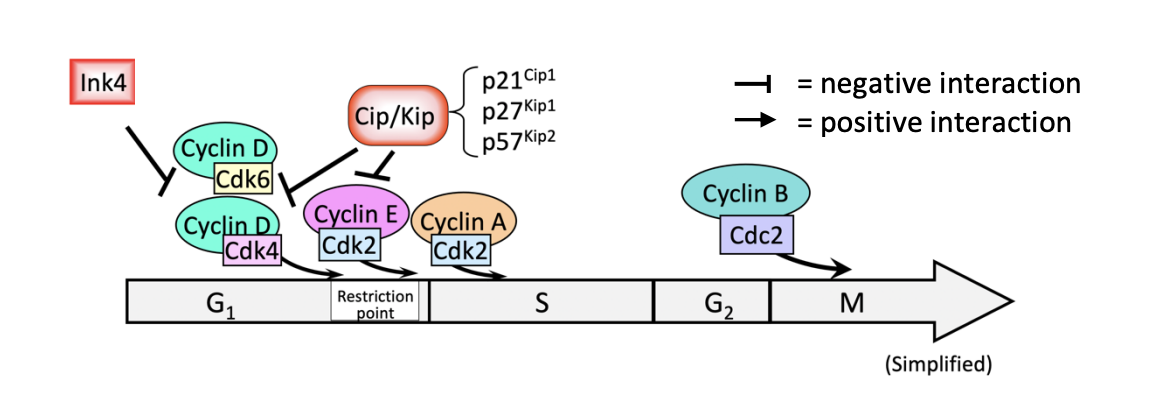
Why are CKI families useful?
increases combinatorial control over the restriction point
Destruction of G1 and G1/S-cyclins
Also dependent upon phospho-degrons
G1/S-cyclin goes through restriction point
it is phosphorylated
forms a phospho-degron
Recognised by SCF
destroyed
so easily go onto the next stage
Role of APC/C
controls ubiquitin-dependent proteolysis
to trigger metaphase → anaphase
Way APC/C recognises its targets
2 sequence signals
destruction box (D-box)
KEN-box
many targets may contain both sequences
How does it work? (compared with SCF)
SCF ubiquination
controlled by targeted phosphylation
BUT
with APC/C
M-CDK phosphykated the APC/C complex
promoting binding to its activator cdc20
form APC/CCdc20
This complex triggers metaphase to anaphase transition through 2 major steps…
How APC/CCdc20 triggers metaphase to anaphase?
ubiquitin-dependent proteolysis of “secruin”
destruction of S and M-cyclins
Step 1
securin is destroed by the complex
releases ‘separase’
separase destroyed cohesion between sister chromatids initiating anaphase
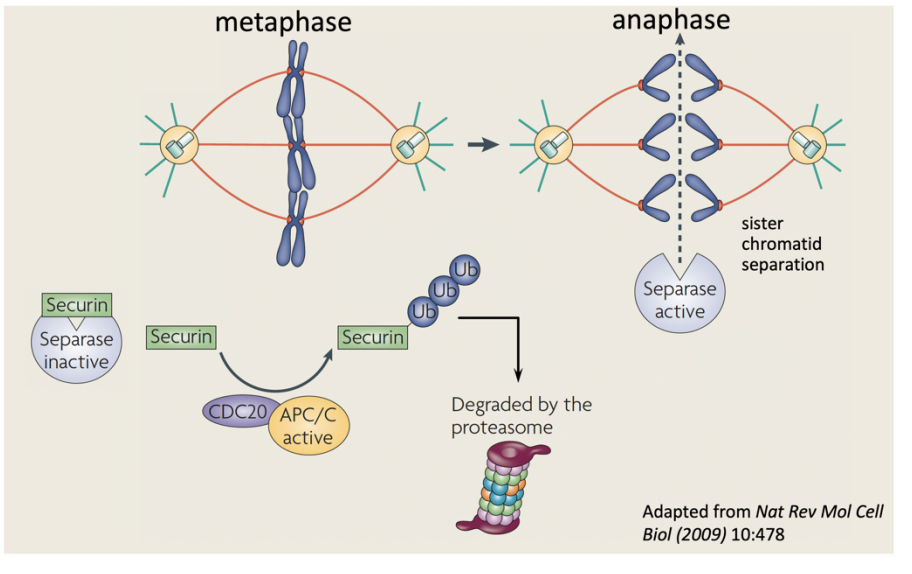
Step 2
S and M-cyclins are destroyed
Initiated by APC/CCdc20
Completed by APC/CCdh1
Allows the progession into G1 phase in the subsequent cell cycle
When should the progression of the cell cycle be stopped?
genome replication is ongoing/ impeded
DNA undergoes damage
spindle assembly is perturbed
How is in appropiate progression prevented?
Surveillance mechanisms: checkpoints
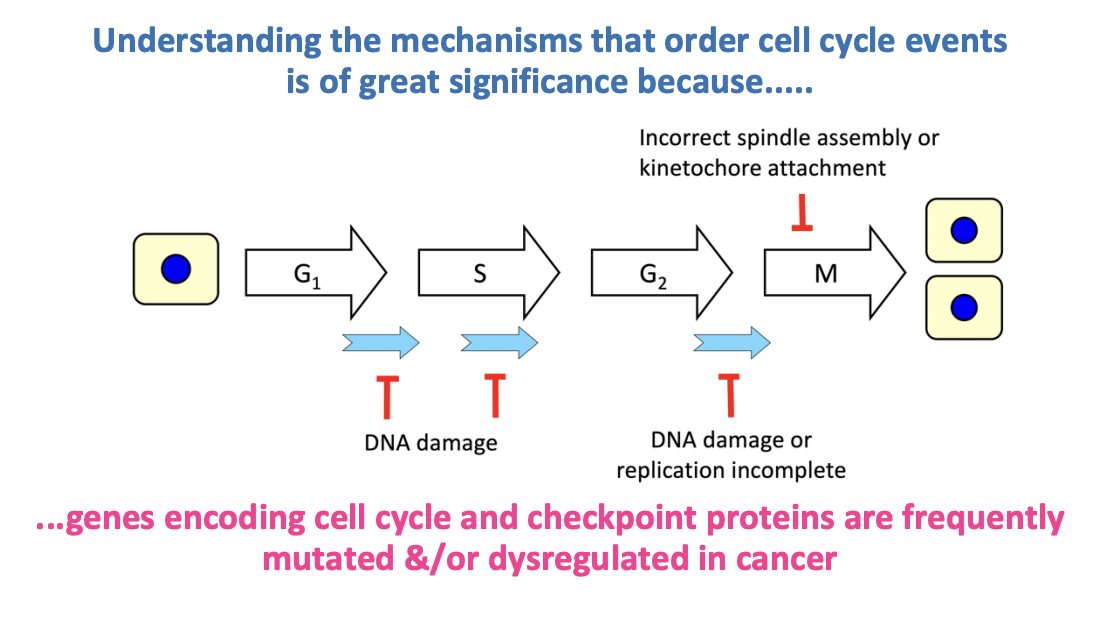
What does DNA damage block promoted by?
Rad9
(radiation sensitive)
How found this out?
collection of radiation sensitive (rad) mutants
Most arrest but are defective in repairing the damage
BUT
One mutant instead could not arrest upon damage
rad 9
proliferates normally despite DNA damage
THEREFORE: Rad9 is needed to stop proliferation after DNA damage!
rad9 is the prototypic ‘checkpoint’ mutant
Then other mutations were identified to do the same thing
found there were two sepraate DNA surveliience mechanisms
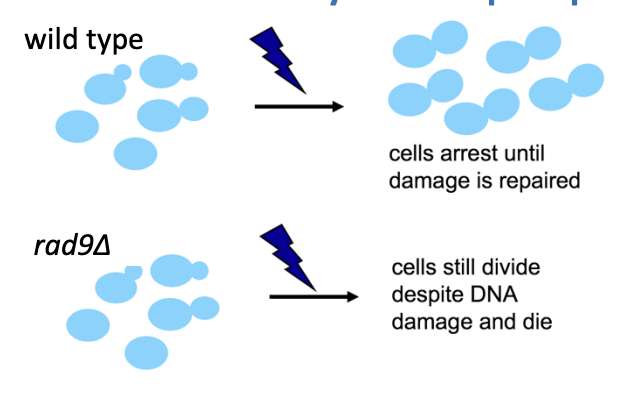
Two checkpoints related to DNA found after finding more mutations
DNA replication checkpoint
DNA damage checkpoint
Found conserved in yeast and humans!
makes senses coz if DNA damaged, it was be really crucial: so needs to be conserved
Checkpoints for DNA integrity are conserved in yeast and humans
Their significant is shown
by the predisposition to cancer
arising from inactivation of ATM or BRCA1

Check point (3)- Metaphase-anaphase transition
Spindle assembly checkpoint (SAC)
Why check?
are all duplicated sisters
attached to the spindle?
bi-oriented?
crucial for chromosomal segreation accuracy
to couple progression and spindle integrity
How was info about SAC found out?
MT poisons
disrupt mitotic spindle or
Observation: cell cycle arrest or delay
Single chromosome not achieving bi-orientation
cell cycle arrest/ delay
SO there must be a checkpoint here but also need
Molecular insight
found with genetic screens with budding yeast
find the key conserved components and pathway
conserved in humans!
Molecular insight: looking at yeast
Wild type + Microtubule poison→ cells arrest @ metaphase
mad and bub mutant + Microtubule poison→cannot arrested
rebud and die with missegregated chromosomes
Mutants used:
mad= ‘mitotic arrest defective’
bub= ‘budding unihibited by benzimidazole’
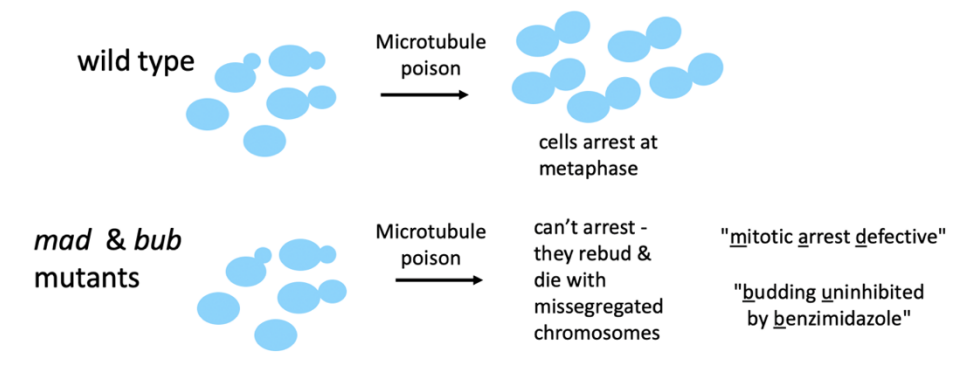
So the overall SAC mechanism we now know! (for unattached kinetochores)
1.Unattached kinetochores
unattached kinetochores relay signals through the SAC
inhibit Cdc20 activation of APC/C
Prevents the destruction of securin
STOPS moving into anaphase
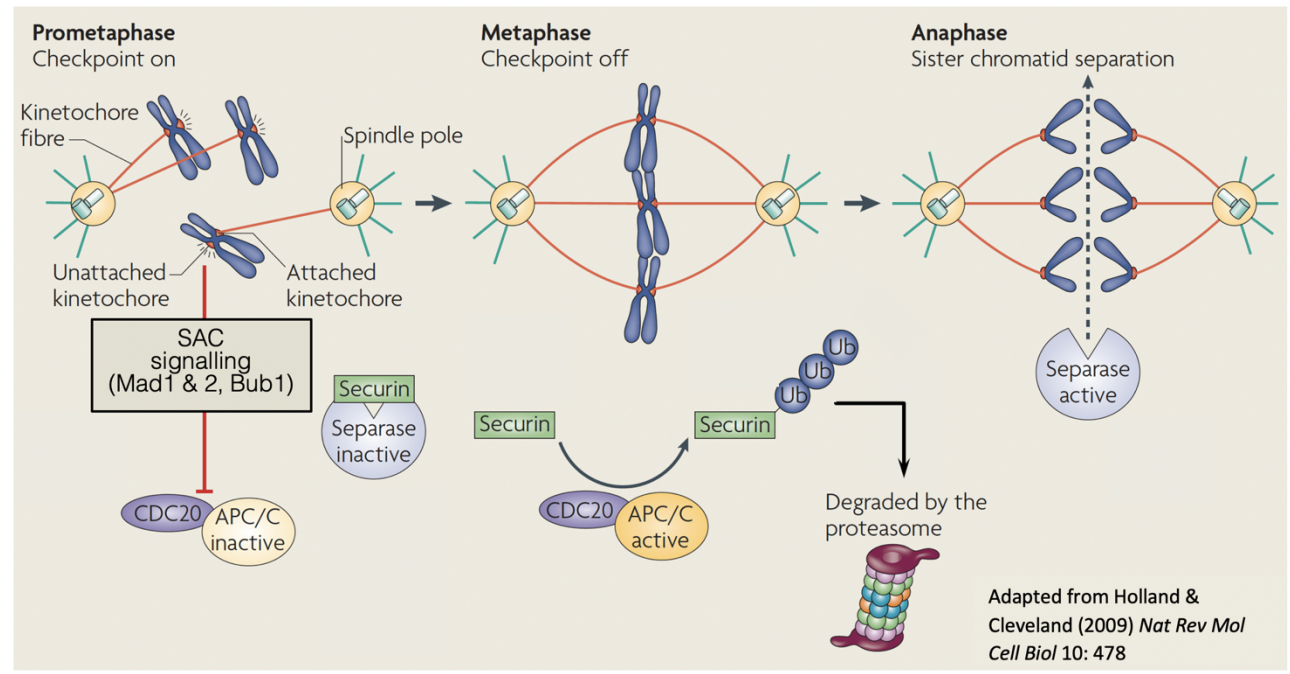
Extra SAC mechanism for attached kinetochores but not got tension
2.Error-correction mechanism
e.g( sister kinetochores are attached to MTs from the sample spindle pole)
attached but not under tension
phosphorylation by mitotic kinase Aurora B
destabilises such attachments
now unattached kinetochore engases the SAC
until correctly re-attached and tension sensed
Once all re-attached andbi-oriented under tension
SAC is satisifed and inhibition ends
can now move into → anaphase
Cdc20 activates APC/C
tagets securin for proeolysis
separase active
cleaves irreversible loss of sister chromatid cohesion
anaphase
Overall check points map
DNA damage check G1/S phase
DNA replication check (S-phase?) and G2
Spindle check (M-phase)
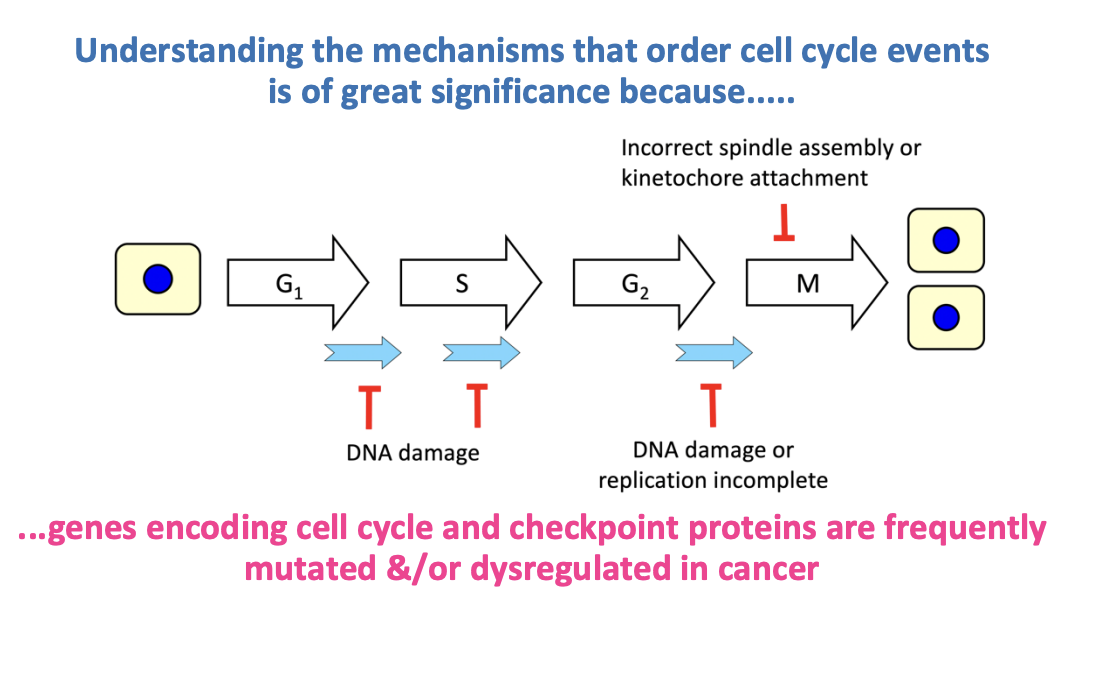
Overall what is enforcing order and irreversibility along the cell cycle?
oscillatory activity of CDKs
surveillance by checkpoints